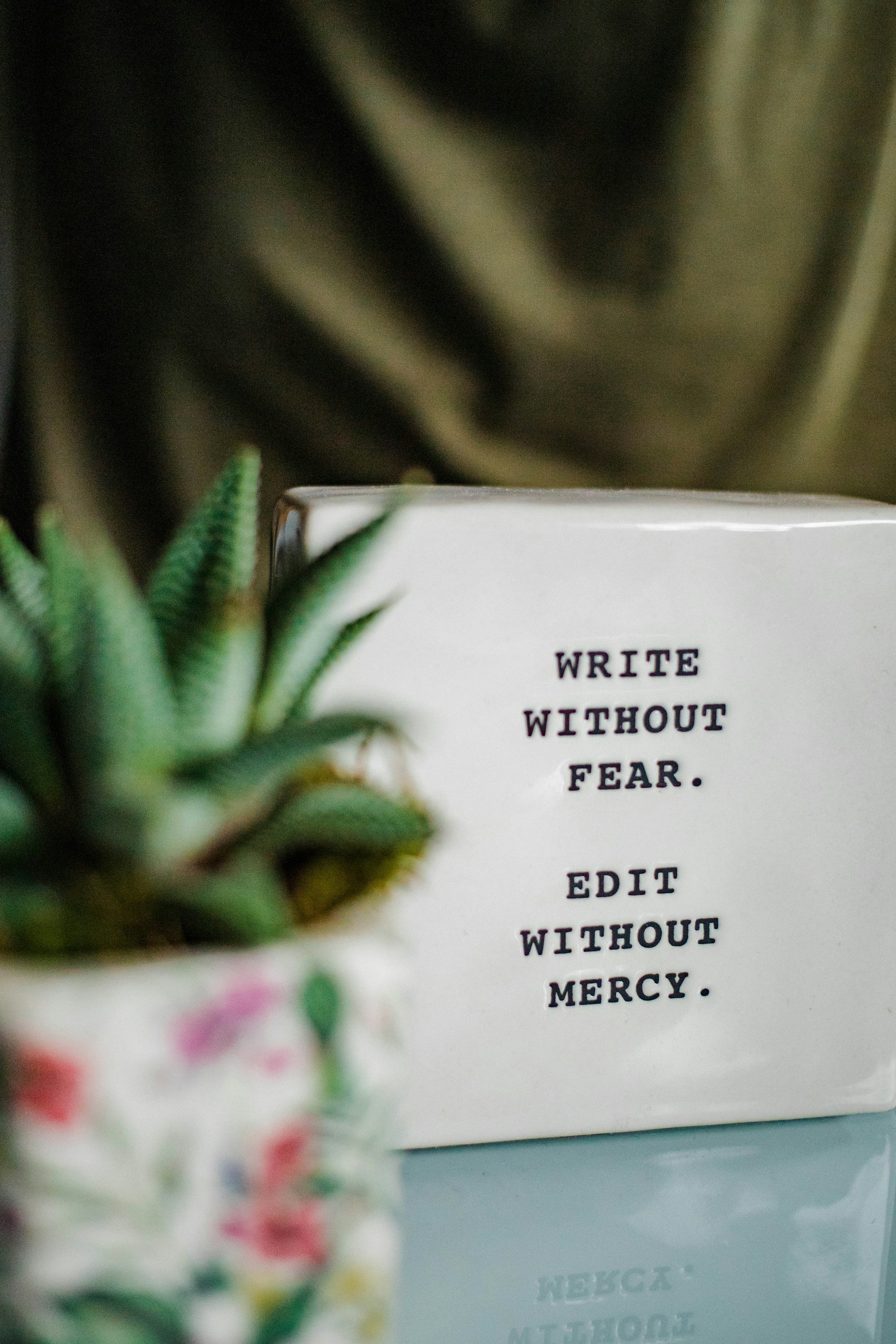A fresh idea struck you, you got to work with research, character development, and world-building, and you set time aside to write diligently. You managed to got the words out of your head and onto the blank page and now, finally, you’ve finished writing your first draft.

What's next?
Editing the first draft of your novel is as important as the story-crafting part of the writing process. It can be daunting, and it can even get a little dreary during the process , but with the right approach, you can make the best out of this seemingly mundane check-point to make your novel and story shine. First-draft editing happens between the writer and their manuscript before anyone else gets to read the story. Effectively editing your first draft involves understanding the different types of edits that you can make to your draft to You will also learn how to identify common mistakes and how to make sure your novel is the best it can be.
Read on to find out more about how you can learn to self-edit your first draft effectively so your readers keep coming back for more.
What is a First Draft?
A first draft of anything you write, be it a novel, an essay, a blog article, fiction, or non-fiction stories, are just the beginning. It is a process of getting your thoughts out onto paper.
If you are writing fiction novel, it is how you get the story that keeps you up at night into a workable format that can be shaped into a reader-friendly story.
As the preliminary version of a piece of writing, authors attempt to develop main characters, flesh out the central plot ideas of their work, and uncover the overarching themes in the process of writing a first draft without zooming in too much into the details of every aspect.
10 Tips On How To Go About Editing Your First Draft
1. Set it aside for a while
First, set your draft aside for a while. Whether it's five minutes, five days, or 5 weeks, it should be out of the writer’s headspace for a little while. When you come back to your first draft, you can approach it with a better perspective.
So leave your first draft to sit on your desktop for as long enough so the writing and narrative doesn’t feel as fresh. This way, you’ll be able to edit your draft with a more critical eye.

2. Approach it with the right mindset
First drafts are like a block of malleable clay. While the basic form and structure of your story exists in the first draft, it most definitely has to be sculpted, refined, and altered so that it would be ready to move forward for the next step.
Your first draft will not be as close as you want it to be to the actual published work; not yet at least. Don't let the pressure of having an "unrefined" or "unfinished" draft get to you and stop you from investing your 100% in making it better.
Some final published writing can resemble it's first version, but it can also very well also look almost nothing like the first draft, and that's okay.
3. Fix the formatting first
Without some basic formatting in place, editing your first draft can turn an eyesore of a lengthy and difficult process. Your reading flow can get broken by distracting line spacing or unreadable font, instead of staying focused on your writing and story.
If you're looking for a platform that can ease your formatting burdens for you from the get-go, writing your first draft on JotterPad can do just this for you.
While you focus your time and energy into fleshing out your story, developing your characters, and making sure your narrative flows, JotterPad can take care of the formatting nuances for you as you write. Format multiple elements of your novel as you write, such as the paragraphs and headings of your body text. You can even consider using JotterPad's novel template to write from the very start. You can use this template to build upon or customize according to your novel needs.

The template allows you to have a visual representation of how your story can look like together with the formatting they need at anytime you would like. It's pre-determined fields and sections makes it all the more easier for you to concentrate on the meat of their writing from the very beginning instead.
4. Read through the entire first draft once briefly
Next, once you're back from a break from your work, read the draft once through rather quickly. Don't reach or your writing and highlighting tools just yet. Take this first read quickly. Instead of fixing any grammatical or spelling errors, become familiar with the book and story once again.
You can use this first read to make mental notes of any changes you want to make to any major plot points, character development or settings, or to identify any inconsistencies or plot holes. But refrain from writing them down or making changes on the spot just yet.
5. Focus on the beginnings and endings during one of your reads
Beginnings and endings are difficult to get right the first time, but they have to make sense for the reader.
Pay ample attention to the beginnings and endings of sentences and paragraphs while you read your draft for the second time. You can even have a go at trying alternate versions of them during the editing phase to see how they form up and flow with the rest of the body of your text. An effective beginning sentence intrigues the reader, and an effective ending sentence concludes what the reader has seen up until that point.
6. Use Stephen King’s "10% Rule"
In his book, “On Writing: A Memoir of the Craft” Stephen King introduces an editing strategy that he terms “the 10 percent rule.”
Instead of getting too attached to your first draft or the amount of "work" you have put into it, King advises that you go in on the editing a little more relentlessly, and delete %10 percent of it. If it’s a 1000-hundred-word draft, make it 900. But with caution, of course. Delete the unnecessary parts of your writing like unnecessary adverbs, filler-words, and details that don't add value to what you're trying to say. Look out for words that don’t add anything to your writing and the meaning wouldn’t be lost if they were gone, and are unnecessary in getting to your point.
Edit excessive parts without hesitation, get rid of unnecessary details, and rearrange parts for better flow.

7. Do a "Character Draft"
For your next read, zoom in on your characters. For each character, read only their parts. During a "character draft", pay attention to your protagonists and antagonists and whether their actions are motivated and urgent. Notice if a supporting character needs more on-page time, or doesn’t belong in a scene. Make sure the antagonists also have clear motivations that would make sense to the reader and result in a good pay-off, even if they’re a mystery to the protagonist in the initial stages of the story.
Refine your characters' POV and make sure the characters are only aware and conscious of what’s in their heads and only see what they can actually see. A character can guess at other people’s thoughts, but not omnisciently know them. As a writer, this may escape you as you write multiple characters at a go.
Go through the dialogue, character by character. Each person should sound like themselves, and it should be clear who is speaking even without dialogue tags.
8. Make structural and technical changes
After zooming in on your characters, pay attention to the structural or technical aspects of your draft.
Some structural questions you can ask yourself include:
- Does each chapter start with a compelling action or image?
- Does each chapter end with both satisfaction and forward motion?
- Have I set the scenes enough?
- Have I ended the scene as early as I can without dragging them on, and still have it feel complete?
- Are there still extra words floating in between?
- Do my sentences end with strong words and images that can be left lingering in my readers' minds?
- Do my paragraphs end with strong sentences or phrases?
This may result in you rearrange scenes or chapters to improve the flow of the story, or adding or deleting scenes or chapters that you feel are unnecessary. Editing can also involve adding sentences or paragraphs where needed. It doesn’t mean adding unnecessary filler words. Instead, take a second look at the writing piece and mark sections where you can add substance, facts, or clearer descriptions.
9. Make a grammar, spelling, and punctuation edit
As one of the final laps on refining your first draft, read your draft again and check for smaller-scale fixes that you can make with your grammar, spelling, and punctuation. If you'd like, you can even get a proof-readers on board to help you with this process. Professional proofreaders would go through your manuscript with a fine-toothed comb and fix any typos, including spelling mistakes and grammatical and punctuation errors. They come in after your final draft, right before you publish.
You might want to hire a proofreader in the final stages of your editing, especially if you're going to self-publish.
10. Have a friend review the draft
Exchange manuscripts with a fellow writer friend, or get a loved one to read your book. Try to get feedback their writing, even if that’s you taking notes while they talk. This would allow you to refer back to your notes while you go in on your draft to make the necessary changes. It would be best if you find someone who reads the genre of what you’re writing, so that they can give you valuable feedback as well.

To share your work easily, efficiently, and without compromising on any of your formatting, export your work to a PDF to share. The Export to PDF plugin on JotterPad allows you to print or share your documents with PDF conversion easily. The plugin will generate a PDF of the same final output as your Markdown document, as a draft or from any template that you could use.
After your vetting and editing, you would have a satisfactory draft in hand. If you're ready, you can immediately publish your book with the help of the ePub plugin on JotterPad as well. This plugin converts your Markdown documents into formatted eBooks and generates and packages your final document with standard electronic publishing formatting. With this plugin, you can export, share, and view your work on multiple other platforms such as Kobo, Amazon Kindle, Barnes, and Noble Nook as well.
It takes several revisions to turn a first draft into something you can publish, and you can only get there with a thorough editing process.
Remember, the best works have all began as first drafts. Streamline your editing process as you tackle your own first draft with these tips, and you're closer to the finish line!
All the best!

